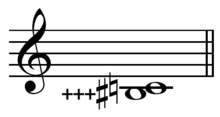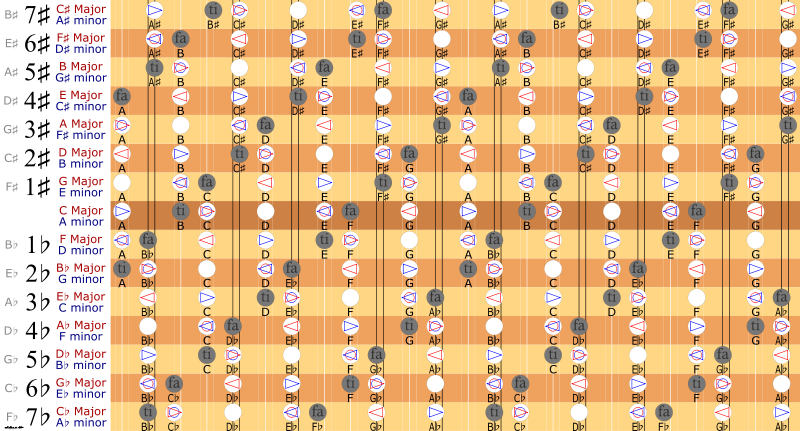- Pythagorean comma
-
Pythagorean comma (PC) defined in Pythagorean tuning as difference between semitones

(A1–m2), or interval between enharmonically equivalent notes (from D♭ to C♯). The diminished second has the same width but an opposite direction (from to C♯ to D♭).In musical tuning, the Pythagorean comma (or ditonic comma[1]), named after the ancient mathematician and philosopher Pythagoras, is the small interval (or comma) existing in Pythagorean tuning between two enharmonically equivalent notes such as C and B♯ (
 Play (help·info)), or D♭ and C♯.[2] It is equal to the frequency ratio 531441:524288, or approximately 23.46 cents, roughly a quarter of a semitone (in between 75:74 and 74:73[3]). The comma which musical temperaments often refer to tempering is the Pythagorean comma.[4]
Play (help·info)), or D♭ and C♯.[2] It is equal to the frequency ratio 531441:524288, or approximately 23.46 cents, roughly a quarter of a semitone (in between 75:74 and 74:73[3]). The comma which musical temperaments often refer to tempering is the Pythagorean comma.[4]The Pythagorean comma can be also defined as the difference between a Pythagorean apotome and a Pythagorean limma,[5] or the difference between twelve just perfect fifths and seven octaves, or the difference between three Pythagorean ditones and one octave (this is the reason why the Pythagorean comma is also called ditonic comma).
The diminished second, in Pythagorean tuning, is defined as the difference between limma and apotome. It coincides therefore with the opposite of a Pythagorean comma, and can be viewed as a descending Pythagorean comma (e.g. from C♯ to D♭), equal to about −23.46 cents.
Contents
Derivation
As described in the introduction, the Pythagorean comma may be derived in multiple ways:
- Difference between two enharmonically equivalent notes in a Pythagorean scale, such as C and B♯ (
 Play (help·info)), or D♭ and C♯ (see below).
Play (help·info)), or D♭ and C♯ (see below). - Difference between Pythagorean apotome and Pythagorean limma.
- Difference between twelve just perfect fifths and seven octaves.
- Difference between three Pythagorean ditones (major thirds) and one octave.
A just perfect fifth has a frequency ratio of 3/2. It is used in Pythagorean tuning, together with the octave, as a yardstick to define, with respect to a given initial note, the frequency ratio of any other note.
Apotome and limma are the two kinds of semitones defined in Pythagorean tuning. Namely, the apotome (about 113.69 cents, e.g. from C to C♯) is the chromatic semitone, or augmented unison (A1), while the limma (about 90.23 cents, e.g. from C to D♭) is the diatonic semitone, or minor second (m2).
A ditone (or major third) is an interval formed by two major tones. In Pythagorean tuning, a major tone has a size of about 203.9 cents (frequency ratio 9:8), thus a Pythagorean ditone is about 407.8 cents.
Size
The size of a Pythagorean comma, measured in cents, is
or more exactly, in terms of frequency ratios:
Circle of fifths and enharmonic change
The Pythagorean comma can also be thought of as the discrepancy between twelve justly tuned perfect fifths (ratio 3:2) (
 play (help·info)) and seven octaves (ratio 2:1):
play (help·info)) and seven octaves (ratio 2:1):Ascending by perfect fifths Note Fifth Frequency ratio Decimal ratio C 0 1 : 1 1 G 1 3 : 2 1.5 D 2 9 : 4 2.25 A 3 27 : 8 3.375 E 4 81 : 16 5.0625 B 5 243 : 32 7.59375 F♯ 6 729 : 64 11.390625 C♯ 7 2187 : 128 17.0859375 G♯ 8 6561 : 256 25.62890625 D♯ 9 19683 : 512 38.443359375 A♯ 10 59049 : 1024 57.6650390625 E♯ 11 177147 : 2048 86.49755859375 B♯ (≈ C) 12 531441 : 4096 129.746337890625 Ascending by octaves Note Octave Frequency ratio C 0 1 : 1 C 1 2 : 1 C 2 4 : 1 C 3 8 : 1 C 4 16 : 1 C 5 32 : 1 C 6 64 : 1 C 7 128 : 1 In the following table of musical scales in the circle of fifths, the Pythagorean comma is visible as the small interval between e.g. F♯ and G♭.
The 6♭ and the 6♯ scales* are not identical - even though they are on the piano keyboard - but the ♭ scales are one Pythagorean comma lower. Disregarding this difference leads to enharmonic change.
* The 7♭ and 5♯, respectively 5♭ and 7♯ scales differ in the same way by one Pythagorean comma. Scales with seven accidentals are seldom used, because the enharmonic scales with five accidentals are treated as equivalent.This interval has serious implications for the various tuning schemes of the chromatic scale, because in Western music, 12 perfect fifths and seven octaves are treated as the same interval. Equal temperament, today the most common tuning system used in the West, reconciled this by flattening each fifth by a twelfth of a Pythagorean comma (approximately 2 cents), thus producing perfect octaves.
Another way to express this is that the just fifth has a frequency ratio (compared to the tonic) of 3:2 or 1.5 to 1, whereas the seventh semitone (based on 12 equal logarithmic divisions of an octave) is the seventh power of the twelfth root of two or 1.4983... to 1, which is not quite the same (out by about 0.1%). Take the just fifth to the twelfth power, then subtract seven octaves, and you get the Pythagorean comma (about 1.4% difference).
History
Chinese mathematicians had been aware of the Pythagorean comma as early as 122 BC (its calculation is detailed in the Huainanzi), and circa 50 BC, Ching Fang discovered that if the cycle of perfect fifths were continued beyond 12 all the way to 53, the difference between this 53rd pitch and the starting pitch would be much smaller than the Pythagorean comma. This much smaller interval was later named Mercator's Comma (see: history of 53 equal temperament).
The first to mention the comma's proportion of 531441:524288 was Euclid, who takes as a basis the whole tone of Pythagorean tuning with the ratio of 9:8, the octave with the ratio of 2:1, and a number A = 262144. He concludes that raising this number by six whole tones yields a value G which is larger than that yielded by raising it by an octave (two times A). He gives G to be 531441.[6] The necessary calculations read:
Calculation of G:
Calculation of the double of A:
See also
References
- ^ not to be confused with the diatonic comma, better known as syntonic comma, equal to the frequency ratio 81:80, or around 21.51 cents. See: Johnston B. (2006). "Maximum Clarity" and Other Writings on Music, edited by Bob Gilmore. Urbana: University of Illinois Press. ISBN 0252030982.
- ^ Apel, Willi (1969). Harvard Dictionary of Music, p.188. ISBN 9780674375017. "...the difference between the two semitones of the Pythagorean scale..."
- ^ Ginsburg, Jekuthiel (2003). Scripta Mathematica, p.287. ISBN 9780766138353.
- ^ Coyne, Richard (2010). The Tuning of Place: Sociable Spaces and Pervasive Digital Media, p.45. ISBN 9780262013918.
- ^ Kottick, Edward L. (1992). The Harpsichord Owner's Guide, p.151. ISBN 0807843881.
- ^ Euclid: Katatome kanonos (lat. Sectio canonis). Engl. transl. in: Andrew Barker (Ed.): Greek Musical Writings. Vol. 2: Harmonic and Acoustic Theory, Cambridge Mass.: Cambridge University Press, 2004, pp. 190–208, here: p. 199.
Intervals (list) Numbers in brackets are the number of semitones in the interval.
Fractional semitones are approximate.Twelve-semitone
(Western)PerfectMajorMinorAugmentedDiminishedCompoundOther systems SupermajorNeutralSubminor7-limitchromatic semitone (⅔) · diatonic semitone (1⅙) · whole tone (2⅓) · subminor third (2⅔) · supermajor third (4⅓) · harmonic (subminor) seventh (9⅔)Other intervals GroupsPythagorean comma · Pythagorean apotome · Pythagorean limma · Diesis · Septimal diesis · Septimal comma · Syntonic comma · Schisma · Diaschisma · Major limma · Ragisma · Breedsma · Kleisma · Septimal kleisma · Septimal semicomma · Orwell comma · Semicomma · Septimal sixth-tone · Septimal quarter tone · Septimal third-tone
MeasurementOthersCategories:- Mathematics of music
- Commas
- Difference between two enharmonically equivalent notes in a Pythagorean scale, such as C and B♯ (
Wikimedia Foundation. 2010.










